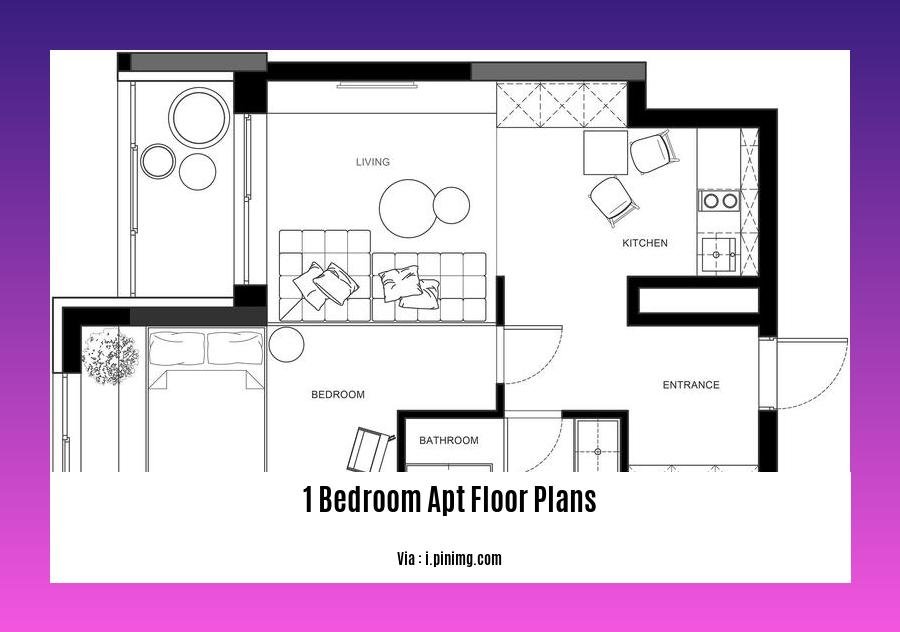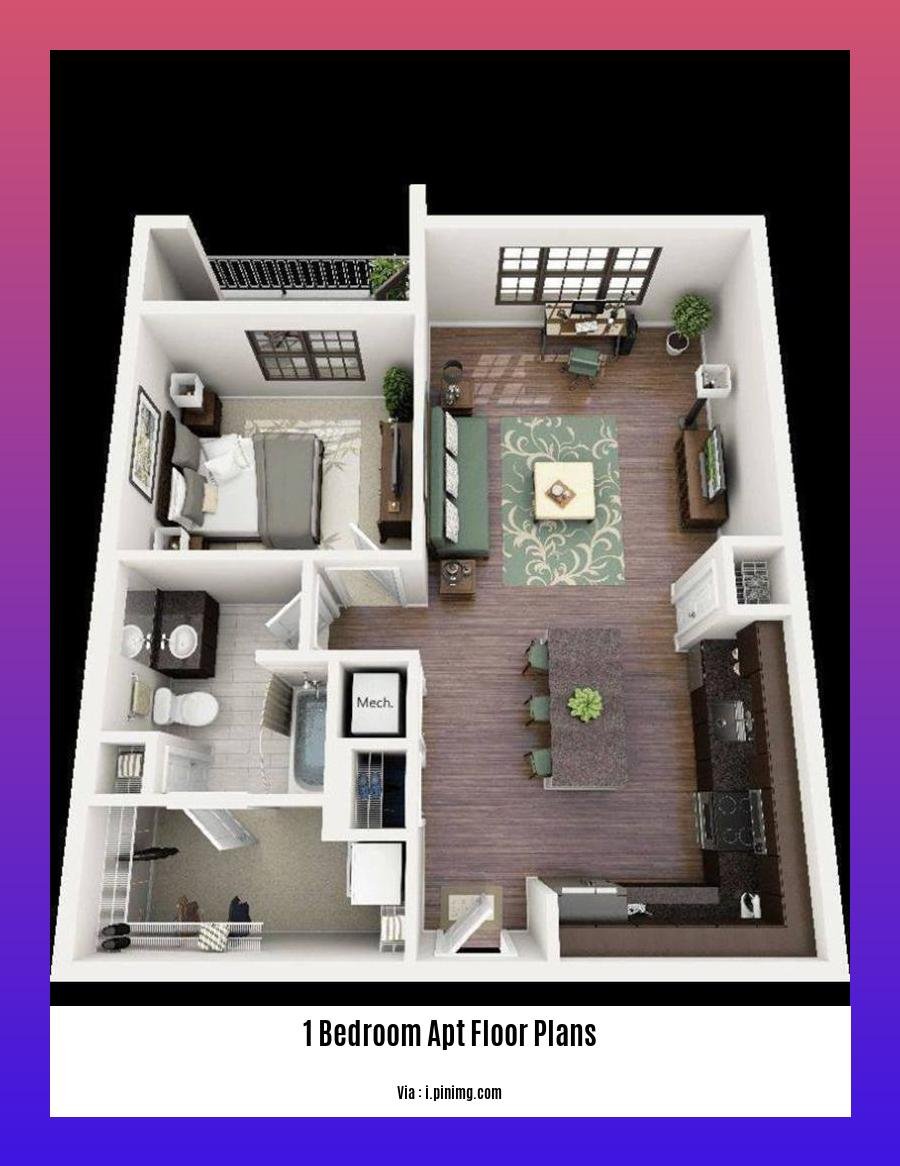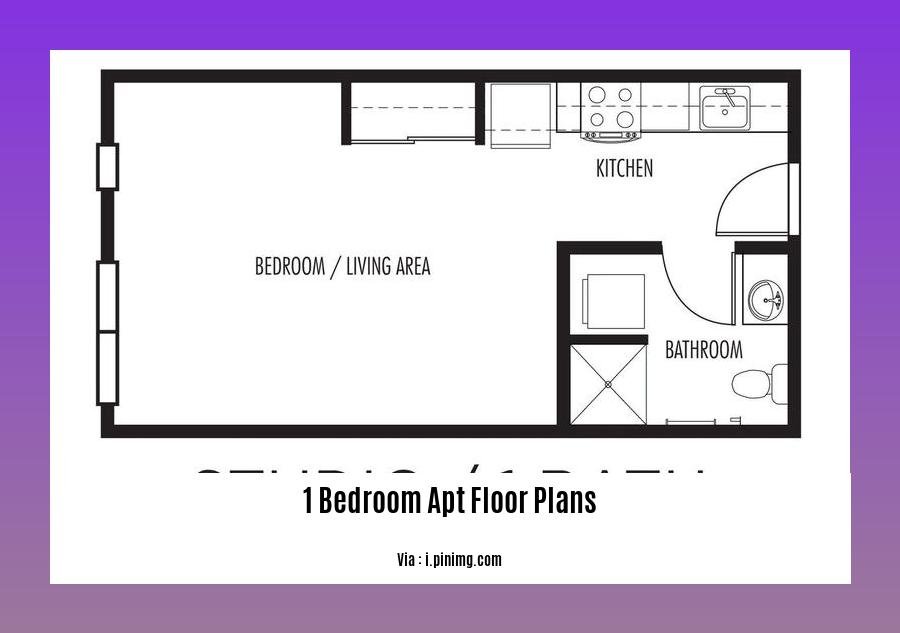Discover the advantages, disadvantages, and stylish design ideas for one-bedroom apartment floor plans in our comprehensive guide, “1 Bedroom Apt Floor Plans: Pros, Cons, and Design Tips.” Explore the benefits of streamlined living, including efficient space utilization, cost-effectiveness, and urban convenience. Weigh the considerations, such as limited space for entertaining and the need for smart storage solutions. From cozy studio-style layouts to efficient designs with separate living areas, unlock the potential of one-bedroom living and create a stylish, functional space that suits your lifestyle.
Key Takeaways:
- One-bedroom apartments are ideal for individuals or couples, ranging from 450 to 750 square feet.
- Typical layouts include a living room, kitchen, enclosed bedroom, and one bathroom.
- Apartment floor plans offer a visual representation of the layout, helping to understand the design before construction.
- The average size of a one-bedroom apartment in the US is between 675 and 715 square feet.
- Making a one-bedroom apartment work for multiple people requires efficient space utilization and smart furniture choices.
- Additional information can be found at: https://upgradedhome.com/one-bedroom-apartment-floor-plans/ and
1 Bedroom Apt Floor Plans: Pros, Cons, and Design Tips

Many people, single professionals, students, and couples, choose one-bedroom apartment floor plans for their homes. It’s crucial to find a floor plan that suits your needs. So, let’s dive into one-bedroom apartment floor plans!
Pros of 1 Bedroom Apt Floor Plans:
-
Cost-effectiveness: One-bedroom apartments are affordable compared to larger units, making them suitable for individuals or couples on a budget.
-
Space Optimization: Efficient use of space in one-bedroom apartments encourages creative storage solutions and smart furniture choices.
-
Convenient Living: One-bedroom apartments are usually smaller, needing less maintenance and cleaning compared to larger homes.
-
Sustainable Option: One-bedroom apartments are an environmentally sustainable choice, consuming less energy and resources.
-
Appealing to Renters: One-bedroom apartments attract tenants who prefer lower rent and less upkeep, making them an appealing investment for landlords.
Cons of 1 Bedroom Apt Floor Plans:
-
Limited Space: One-bedroom apartments can feel cramped for those accustomed to more space or those with a lot of belongings.
-
Privacy Concerns: In some one-bedroom apartment floor plans, sound can easily travel between living areas, making it challenging to maintain privacy.
-
Lack of Storage: Storage space can be limited in one-bedroom apartments, especially if you own many items or bulky furniture.
-
Limited Guest Space: Entertaining guests can be challenging in a one-bedroom apartment due to the limited space.
-
Less Flexibility: One-bedroom apartments provide less flexibility compared to larger units, especially if your needs or lifestyle changes.
Tips for Optimizing 1 Bedroom Apt Floor Plans:
-
Maximize Vertical Space: Utilize walls and vertical space for storage solutions, wall-mounted furniture, and stackable items.
-
Choose Multifunctional Furniture: Invest in furniture that serves multiple purposes, such as a sofa bed or a coffee table with built-in storage.
-
Create Separate Zones: Use area rugs, dividers, or furniture placement to create distinct zones for living, dining, and sleeping areas.
-
Let in Natural Light: Keep curtains open during the day to maximize natural light and make the space feel airier.
-
Customize Storage: Consider installing custom storage solutions, such as built-in shelves or under-bed storage, to maximize space utilization.
One-bedroom apartment floor plans offer both advantages and disadvantages. By carefully considering your lifestyle, space requirements, and budget, you can determine if a one-bedroom apartment is the right choice for you. With creative design and smart space optimization, you can create a comfortable and stylish home in a one-bedroom apartment.
-
If you’re looking for compact yet functional layout plans, explore our curated collection of 1 bedroom apartment floor plans with dimensions.
-
Discover the ultimate comfort and efficiency with our 1 bedroom apartment layout designs, tailored to provide a harmonious living experience.
-
Unleash your creativity and bring your vision to life with our 1 bedroom flat plan drawing in Nigeria collection, featuring diverse options adapted to local requirements.
-
Elevate your living experience with our meticulously designed 1 bedroom granny annexe floor plans, offering a cozy and functional living space for your loved ones.
Lifestyle Considerations When Opting for a One-Bedroom Apartment

Are you deliberating between a studio and a one-bedroom apartment? It’s not just about the extra room; it’s about aligning your lifestyle with your living space. Let’s explore the crucial factors to consider when making this choice.
1. Privacy Preferences:
-
Evaluate your need for privacy. A one-bedroom apartment offers distinct living and sleeping areas, ensuring a private sanctuary.
-
If you prefer an open and airy layout, a studio might suit you better, allowing you to seamlessly move between different areas.
2. Space Requirements:
-
Assess your belongings, furniture, and potential need for a home office or guest space. A one-bedroom apartment provides more space for activities, storage, and entertaining.
-
If you value space optimization, a studio can be a cozy and efficient option, requiring creative storage solutions and multifunctional furniture.
3. Lifestyle and Habits:
-
Consider your daily routine and habits. Do you prefer to cook elaborate meals or entertain guests frequently? A one-bedroom apartment offers a separate kitchen and more space for hosting.
-
If you’re often on the go and value convenience, a studio might be more suitable, minimizing cleaning and maintenance tasks.
4. Budget Considerations:
-
One-bedroom apartments typically come with a higher price tag due to the extra space and amenities. Evaluate your budget and determine if the additional cost aligns with your financial goals.
-
Studios, while generally more affordable, may require additional expenses for storage solutions or frequent dining out if you lack cooking facilities.
5. Future Plans:
-
Think about your long-term plans. If you anticipate sharing your space with a partner, roommate, or expanding your family, a one-bedroom apartment offers more flexibility and adaptability.
-
If you’re seeking a temporary living arrangement or prefer a minimalist lifestyle, a studio can be a suitable choice.
Key Takeaways:
-
Consider your privacy preferences and the need for distinct living and sleeping areas.
-
Evaluate your space requirements, including furniture, belongings, and potential need for a home office or guest space.
-
Assess your lifestyle and habits, considering cooking preferences, entertaining needs, and frequency of being at home.
-
Compare the financial implications of a one-bedroom apartment versus a studio, including rent, utilities, and potential additional expenses.
-
Think about your long-term plans and whether your chosen apartment can accommodate potential changes in your lifestyle or family situation.
Sources:
Studio vs. 1-Bedroom Apartments: Which Is Right for You?
10 Pros and Cons of Living in a One-Bedroom Apartment
Financial implications and budgeting strategies for one-bedroom apartment living
Selecting a one-bedroom apartment marks a significant financial commitment. Let’s explore the key costs involved and budgeting strategies to ensure you make an informed decision:
Key expenses to consider:
-
Rent: Often the biggest expense, rent varies based on factors like location, amenities, and the apartment’s condition. Research rental rates in your area to set realistic expectations.
-
Security deposit: Typically equal to one or two months’ rent, this deposit serves as a safety net for landlords in case of damages. Keep this amount readily available.
-
Utilities: Expenses like electricity, water, and heating can add up. Consider the apartment’s energy efficiency and whether utilities are included in the rent.
-
Moving expenses: Whether you hire movers or do it yourself, factor in costs for packing materials, transportation, and possibly a cleaning service for your old place.
Budgeting strategies:
- Create a comprehensive budget:
- Include income, current expenses, and estimated costs for one-bedroom living.
-
Use budgeting apps or spreadsheets to track expenses and stay on track.
-
Prioritize needs vs. wants:
- Distinguish between essential expenses (rent, utilities) and discretionary ones (entertainment, dining out).
-
Allocate funds accordingly, prioritizing necessities.
-
Set aside an emergency fund:
- Aim for 3-6 months of living expenses saved to cover unexpected costs like job loss or medical bills.
-
This fund provides a financial safety net.
-
Consider roommates:
- Sharing an apartment with a roommate can significantly reduce rent and utility costs.
-
Choose compatible roommates to ensure a harmonious living arrangement.
-
Negotiate the rent:
- When possible, negotiate the rent, especially if you’re a long-term tenant or renting during off-peak seasons.
- Politely inquire about potential discounts or concessions.
Key Takeaways:
- Understand the financial implications of one-bedroom apartment living, including rent, security deposit, utilities, and moving expenses.
- Create a comprehensive budget that outlines your income, expenses, and financial goals.
- Prioritize needs over wants and allocate funds accordingly.
- Build an emergency fund to cover unexpected costs and provide financial stability.
- Consider sharing the apartment with roommates to reduce living expenses.
- Don’t hesitate to negotiate the rent, especially if you’re a long-term tenant.
Sources:
1. How to Budget for an Apartment: The Ultimate Guide
2. One-Bedroom Apartment Budget: How Much Will It Cost?
Essential Factors to Assess When Selecting a One-Bedroom Apartment
As you embark on the journey of finding your ideal one-bedroom apartment, there are several key factors to consider that will shape your living experience. Let’s dive into these essential elements to ensure you make an informed decision:
1. Space and Layout:
- Evaluate the apartment’s square footage: Does it align with your needs and lifestyle? Consider the size of your furniture and belongings to ensure a comfortable fit.
- Pay attention to the layout: A well-designed floor plan can maximize space and functionality. Look for a layout that separates the living and sleeping areas, providing privacy and distinct zones for different activities.
2. Location:
- Proximity to work or school: Consider the commute time and transportation options. A convenient location can save you time and reduce stress.
- Neighborhood amenities: Access to nearby shops, restaurants, parks, and public transportation can enhance your quality of life. Research the neighborhood to understand its vibe and offerings.
3. Budget:
- Rent: Determine your budget and stick to it. Consider additional expenses such as utilities, parking, and any applicable fees.
- Affordability: Calculate the percentage of your income that will go towards rent. Experts recommend spending no more than 30% of your income on housing.
4. Amenities:
- Essential amenities: Assess the availability of essential amenities such as laundry facilities, parking, and high-speed internet. Consider any additional amenities that are important to you, such as a gym, pool, or rooftop deck.
- Pet-friendliness: If you have furry companions, ensure the apartment allows pets and inquire about any pet fees or restrictions.
5. Building Condition and Safety:
- Overall condition: Inspect the building’s exterior, common areas, and the apartment itself for signs of neglect or disrepair.
- Security measures: Consider the building’s security features, such as controlled access, security cameras, and adequate lighting.
6. Lease Terms and Conditions:
- Review the lease agreement carefully: Understand the terms, including the lease duration, rent payment details, and any additional fees or charges.
- Negotiate if necessary: Don’t hesitate to negotiate terms that are important to you, such as the length of the lease or the inclusion of specific amenities.
7. Your Lifestyle and Needs:
- Consider your lifestyle and preferences: Are you a social butterfly who loves to entertain guests? Or do you prefer a quiet and private space? Choose an apartment that aligns with your lifestyle and needs.
- Think about the future: If you plan to expand your family or have frequent visitors, consider a one-bedroom apartment with potential for growth or flexibility in terms of space.
Key Takeaways:
- Evaluate the apartment’s square footage and layout to ensure it meets your needs and lifestyle.
- Consider the location’s proximity to work or school, neighborhood amenities, and transportation options.
- Set a budget and calculate the percentage of your income that will go towards rent.
- Assess essential amenities, pet-friendliness, and any additional amenities that are important to you.
- Inspect the building’s condition, safety features, and security measures.
- Review the lease agreement carefully, understand the terms, and negotiate if necessary.
- Consider your lifestyle, preferences, and future plans when making your decision.
Sources:
- One-Bedroom Apartment Essentials
- 10 Things to Consider When Choosing a One-Bedroom Apartment
FAQ
Q: What are the typical features of a one-bedroom apartment floor plan?
A: Typically, one-bedroom apartments include a separate living room and kitchen, an enclosed bedroom, and one bathroom. The average size ranges from 675 to 715 square feet, with some exceeding 1,000 square feet.
Q: How can I make the most of a one-bedroom apartment for multiple people?
A: Optimizing space through careful furniture choices and space utilization techniques is essential. Consider using multifunctional furniture, utilizing vertical storage, and defining different areas for living, sleeping, and dining.
Q: What are the advantages of choosing a one-bedroom apartment?
A: One-bedroom apartments offer several benefits, including more privacy, additional space for guests or entertaining, and increased storage capacity compared to studio apartments. They are suitable for couples, small families, or roommates seeking a cozy and efficient living space.
Q: What factors should I consider when choosing a one-bedroom apartment floor plan?
A: Consider your lifestyle and needs, including your preference for open-concept living or separate spaces. Evaluate your budget and the desired location, considering proximity to work, school, and amenities.
Q: How can I design a one-bedroom apartment to maximize functionality and style?
A: To create a functional and stylish one-bedroom apartment, consider defining separate areas for living, sleeping, and dining. Utilize multifunctional furniture, incorporate storage solutions, and choose a cohesive design theme to create a visually appealing and welcoming space.
- Embossed Backsplash Tile Kitchen: Add Texture And Style - December 22, 2025
- Ceramic Tile Backsplash Ideas for Your Kitchen Remodel - December 21, 2025
- Contemporary Kitchen Backsplash Ideas for a Stylish Home - December 20, 2025










